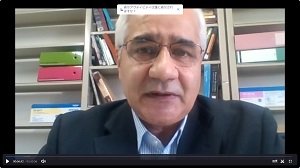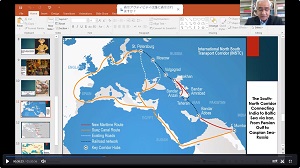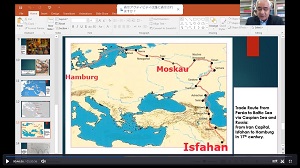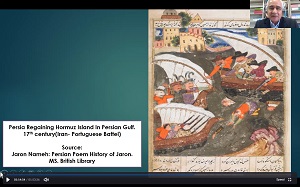News
2022年度 第1回定例研究会「Connecting East Asia to Europe via the Caspian Sea, Caucasus and Russia: Iran`s plan to open a new Silk Road during the Safavid era (17th century)」セファトゴル特任教授(着任研究会)が開催されました
報告
1st Tobunken Staff Seminar in AY 2022 "Connecting East Asia to Europe via the Caspian Sea, Caucasus and Russia: Iran's plan to open a new Silk Road during the Safavid era (17th century)" (Lecturer: Prof. Mansur Sefatgol) was held online on June 16, 2022, attended by 45 people.
The establishment of the Safavid Empire (1501-1736) was the beginning of a relatively new structure in Iran. At the same time there were dramatic changes in West Asia and global conditions. The rise of the Ottomans, Mughal India, Uzbek Khanate, Russian Tsardom, and the presence of the Portuguese in the Persian Gulf led to the decline of traditional trade network and route from China to Europe via Iran. These changes encouraged Iran to start design a plan for the South- North Corridor.
It seems that during this period a large plan was designed to restore maritime sovereignty over the Caspian Sea and, the Persian Gulf. The plan included a number of important sectors, such as construction and securing Iran's internal roads and ports, regaining islands in the Persian Gulf like Hormuz Island from the Portuguese, efforts to establish naval fleets, promoting trade through the Volga to Northern Europe, as well as access through the Caucasus to the Black Sea, establishing links with East Asian governments including Siam and effort to access Japanese ports. The aim of this plan was to link East Asia to Europe through the way that can be called the Southern-Northern Silk Road. Southeast Asia, especially Siam, was the most important center for Iranian traders and from there, they tried to do business with Japan. Japanese copper, porcelain and lacquered wares and camphor were amongst commodities that merchants exported from Nagasaki to the Persian Gulf. What has received less attention so far is the study of the maritime history of Iran and West Asia based on indigenous source materials and we still need more research to provide an Asian picture of maritime and land route trade activity of West Asia.
当日の様子
 |  |
 |  |
開催情報
日時:2022年6月16日(木)14時~16時
会場:オンライン(Zoomミーティング)
題目:Connecting East Asia to Europe via the Caspian Sea, Caucasus and Russia: Iran`s plan to open a new Silk Road during the Safavid era (17th century)
発表者: マンスール・セファトゴル(東京大学東洋文化研究所・特任教授 / テヘラン大学教授)
司会:森本 一夫(東京大学東洋文化研究所・教授)
使用言語:英語
要旨:
From the 16th to the 18th centuries, Iran/Persia started an important plan to open new routes for trade with Europe and East Asia. In the 17th century, these efforts reached to its zenith. Thus, in order to facilitate trade and access, Iran launched a major program that included a number of important sectors, such as construction and securing Iran's internal roads and ports, retaking islands and coasts in the Persian Gulf from the Portuguese, efforts to establish naval fleets in the Persian Gulf and the Caspian Sea, promoting trade through the Volga to Northern Europe, as well as access through the Caucasus to the Black Sea, and establishing a naval base on the Black Sea coast, establishing links with East Asian governments including Thailand/Siam to access China's ports and commercial market, and effort to access the Japanese ports. The aim of this plan was to link East Asia to Europe through the way that can be called the Southern-Northern Silk Road. Although the beginning of the plan was successful, it seems to have faced problems during the 17th century. Iran's domestic issues and external issues such as the obstacles and sabotage of Russia, European companies, and the Ottomans were serious obstacles to the implementation of this program. The present study tries to investigate this program with an emphasis on the source materials issue.
登録種別:研究活動記録
登録日時:MonJun2714:36:532022
登録者 :セファトゴル・板橋・田川
掲載期間:20220628 - 20220928
当日期間:20220616 - 20220616

